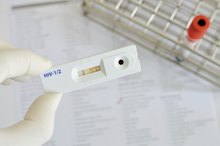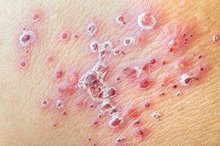Five Stages of HIV & AIDS
HIV is an acronym for human immunodeficiency virus, the virus that causes AIDS, or acquired immune deficiency syndrome. The Centers for Disease Control and Prevention (CDC) report that the virus attacks the immune system, eventually leaving the body prone to multiple different types of infections. The CDC estimates that approximately 1.1 million people are currently living with HIV or AIDS. A person can be infected with HIV, but not yet have AIDS, because the virus has not yet severely weakened the immune system. The disease usually follows a five-stage progression.
If you are experiencing serious medical symptoms, seek emergency treatment immediately.
Acute Infection
AIDS.gov, a resource provided by the U.S. Department of Health and Human Services, reports that acute infection occurs within two to four weeks after infection with HIV. The symptoms of the acute infection are similar to a bad flu or, as AIDS.gov describes it, "the worst flu ever." During the acute infection phase, AIDS.gov reports that large amounts of virus are being produced in the body, attacking CD4 T cells, which are one type of cell that makes up the immune system. Eventually the body brings the virus back down to low levels, and the CD4 T cell count increases.
- AIDS.gov, a resource provided by the U.S. Department of Health and Human Services, reports that acute infection occurs within two to four weeks after infection with HIV.
- During the acute infection phase, AIDS.gov reports that large amounts of virus are being produced in the body, attacking CD4 T cells, which are one type of cell that makes up the immune system.
Clinical Latency
Signs of Full-Blown AIDS
Learn More
The next stage of HIV infection is clinical latency, a period that may extend for several years, where the infected person feels no symptoms. Thebody.com, an online HIV/AIDS resource, reports that often the only clue that a person is infected with HIV is that he would test positive in an HIV test. Additionally, he may have larger-than-normal lymph nodes. AIDS.gov reports that this stage can persist for a period of eight years or longer.
- The next stage of HIV infection is clinical latency, a period that may extend for several years, where the infected person feels no symptoms.
- AIDS.gov reports that this stage can persist for a period of eight years or longer.
Early Stage AIDS
Early stage AIDS occurs when the body's immune system is compromised enough to be susceptible to some mild bacterial, viral and fungal infections. The National Institute of Allergy and Infectious Diseases (NIAID) reports that headache and fatigue are also common symptoms of early stage AIDS.
Middle-Stage AIDS
First Year HIV Symptoms
Learn More
The middle stage of AIDS is characterized, according to thebody.com, as an increase in severity of infections. The person may experience troublesome fungal infections of the mouth or vagina called thrush, which manifests as a white or yellow film that may cause irritation. Thebody.com reports that other symptoms characteristic of middle-stage AIDS include: herpes infection of the mouth and genitals (cold sores), diarrhea, more dramatic weight loss and persistent fevers.
Late-Stage AIDS
In late-stage AIDS, infections may make the infected person consistently and often severely sick. Thebody.com reports that these infections include Mycobacterium avium complex disease (caused by a fungus) Pneumocystis carinii pneumonia (caused by a bacteria), and cytomegalovirus (caused by a virus). The NIAID reports that chronic severe diarrhea, intense night sweats, memory loss, depression and other disorders of the brain may occur in late-stage AIDS. Furthermore, the person may develop type of cancer called Kaposi's sarcoma that causes red, brown or purple blotches on the skin of the face.
- In late-stage AIDS, infections may make the infected person consistently and often severely sick.
- Furthermore, the person may develop type of cancer called Kaposi's sarcoma that causes red, brown or purple blotches on the skin of the face.
Related Articles
References
- HIV/AIDS: The Basics. AIDSInfo. U.S. Department of Health and Human Services. July 3, 2019
- HIV Testing. AIDSInfo. U.S. Department of Health and Human Services. June 20, 2019
- What is an Opportunistic Infection? AIDSInfo. U.S. Department of Health and Human Services. May 28, 2019
- AIDS Case Definition. AIDSInfo. U.S. Department of Health and Human Services.
- Burnett JC, Broz D, Spiller MW, Wejnert C, Paz-Bailey G. HIV Infection and HIV-Associated Behaviors Among Persons Who Inject Drugs - 20 Cities, United States, 2015. MMWR Morb Mortal Wkly Rep. 2018 Jan 12;67(1):23-28. doi:10.15585/mmwr.mm6701a5.
- Centers for Disease Control and Prevention (CDC). Revised surveillance case definition for HIV infection--United States, 2014. MMWR Recomm Rep. 2014 Apr 11;63(RR-03):1-10.
- Manzardo C, Guardo AC, Letang E, Plana M, Gatell JM, Miro JM. Opportunistic infections and immune reconstitution inflammatory syndrome in HIV-1-infected adults in the combined antiretroviral therapy era: a comprehensive review. Expert Rev Anti Infect Ther. 2015 Jun;13(6):751-67. doi:10.1586/14787210.2015.1029917.
- Stein R, Xu S, Marano M, Williams W, Cheng Q, Eke A, Moore A, Wang G. HIV Testing, Linkage to HIV Medical Care, and Interviews for Partner Services Among Women - 61 Health Department Jurisdictions, United States, Puerto Rico, and the U.S. Virgin Islands, 2015. MMWR Morb Mortal Wkly Rep. 2017 Oct 20;66(41):1100-1104. doi:10.15585/mmwr.mm6641a2.
Writer Bio
Leah DiPlacido, a medical writer with more than nine years of biomedical writing experience, received her doctorate in immunology from Yale University. Her work is published in "Journal of Immunology," "Arthritis and Rheumatism" and "Journal of Experimental Medicine." She writes about disease for doctors, scientists and the general public.









